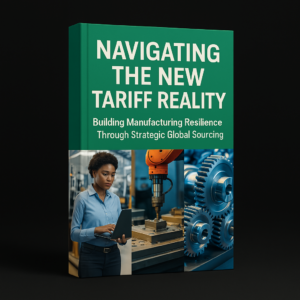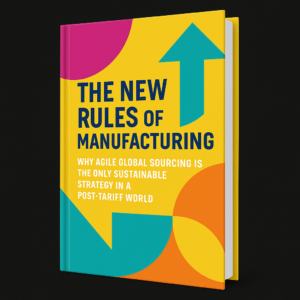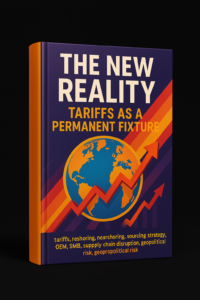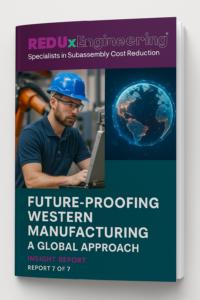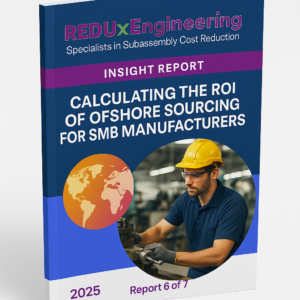
Manufacturing profit margins have come under intense pressure. In 2025, manufacturers face a confluence of cost escalations: rising labor wages, increased raw material prices, and new tariff-imposed costs. The National Association of Manufacturers reports input costs are expected to rise ~2.7% over the next 12 months, on top of the elevated base of recent years. Many small to mid-sized manufacturers (SMBs) now find their margins uncomfortably thin. This report provides a roadmap of cost reduction strategies – focusing on strategic sourcing and operational efficiency – to help manufacturers reclaim their margin and thrive despite economic headwinds.
The Margin Squeeze – By the Numbers:
Several indicators highlight why margins are tighter now than a few years ago:
- Labor Costs: U.S. manufacturing wages have consistently risen. As of early 2025, average hourly earnings for production workers hit record highs (over $30.00/hour, not including benefits). Total compensation (wages + benefits) climbed ~4% in the past year. A mid-sized manufacturer with 200 shop floor employees, for example, might be paying $1–2 million more in annual payroll now than two years ago for the same headcount. While higher wages are good for workers, they squeeze operating profit unless productivity or prices increase in tandem.
- Raw Materials and Components: After the volatility of 2021–2023, many commodity prices stabilized but at elevated levels. Steel, aluminum, plastics, and electronic components are still significantly more expensive than pre-2020 benchmarks. Supply chain disruptions and inflation pushed costs up ~20–30%, and not all have come down. The Producer Price Index for processed goods remains high, meaning manufacturers are paying more for inputs. For example, injection molding resin prices and electronic component prices saw double-digit % increases in recent years and have only partly retreated.
- Tariffs and Trade Costs: As detailed earlier, the U.S. tariffs introduced in 2025 effectively tax imported components an extra 10–25%. Companies that rely on global supply chains now face higher landed costs or must re-source items, sometimes at higher cost domestically. Tariffs function like a new cost line item, directly reducing gross margin if not mitigated.
- Energy and Overhead: Energy prices (electricity, gas) have fluctuated, but many regions see higher industrial electricity rates than a few years ago, contributing to higher overhead. Additionally, interest rates rose during 2023–2024, making financing and capital investments pricier – a subtle drain on cash flow for leveraged manufacturers.
All these factors contribute to a situation where a manufacturer’s cost of goods sold (COGS) has ballooned. It’s not uncommon to hear of a company whose gross margin slid from, say, 40% to 30% purely due to external cost increases. For an SMB, that 10-point margin drop could be the difference between healthy profits and breakeven.
Strategic Sourcing: The 20% that Drives 80% of Cost
To counter rising costs, one high-impact area to examine is the bill of materials (BOM) and sourcing strategy. Often, a handful of purchased components or sub-assemblies constitute a large share of total product cost. The Pareto principle applies: typically, 20% of your parts make up 80% of your material spend. These are usually complex or high-value items like electronics, machined parts, castings, or assemblies.
Selective Offshore Sourcing for High-Cost Components: As discussed in a previous research paper that I recommended to you, offshoring production of certain components can yield dramatic savings due to lower labor and overhead costs abroad. The key is to identify which components benefit most from offshoring. Ideal candidates are:
- Labor-intensive items (where U.S. labor adds a lot of cost). Example: a wiring harness that requires many manual assembly hours – offshore labor at a fraction of the cost can cut its price by 30–50%.
- High-volume standardized parts (where overseas suppliers have economies of scale). Example: metal enclosures or brackets that Asian suppliers churn out by the millions, achieving unit costs impossible for a small U.S. shop to match.
- Components with minimal IP or strategic sensitivity, so they can be produced externally with low risk.
For those target parts, engaging an offshore manufacturing partner can often save 20–40% per unit. Consider a case: Our HVAC client was sourcing fan assemblies domestically at $50 each. By sourcing the assembly from a supplier in Vietnam at $35 each (including tariffs), they saved $15 per unit – a 30% cost cut, translating to $1.5M annual savings on 100k units. This single change improved their gross margin by 4 percentage points across their product line.
It’s worth noting that these savings don’t necessarily require moving all production offshore – often a hybrid approach works. For instance, keep final assembly in the U.S. for flexibility and optics, but outsource sub-components that drive cost. This is how many “Made in USA” products still achieve competitive costs: critical parts are globally sourced (quietly), final integration is local.
Supplier Re-negotiation and Consolidation: Another strategy is leveraging volume and competition. If you currently buy similar materials from multiple suppliers, consolidating volume to one can earn bulk discounts. Alternatively, renegotiate contracts with current suppliers citing the availability of lower-cost options. In 2025’s environment, suppliers know customers are price-sensitive; they may offer better pricing (or at least hold prices flat) to keep your business. Additionally, check if your suppliers’ input costs have eased (e.g., if steel prices dropped from peak) – ensure those reductions are passed to you, not just boosting your supplier’s margin.
Operational Efficiency & Cost Reduction:
Beyond sourcing, examine internal operations for cost-saving opportunities:
- Automation and Process Improvement: With labor so pricey, investing in automation can have a strong payback. Simple fixes like adding jigs/fixtures to reduce assembly time, or more advanced ones like collaborative robots (cobots) for repetitive tasks, directly reduce labor hours per unit. Manufacturers who reinvest savings into automation often see a virtuous cycle of cost reduction. For example, one study by Deloitte notes companies reinvesting in automation achieved up to 30% improvement in productivity, effectively lowering per-unit labor cost.
- Lean and Waste Elimination: Conduct a lean audit of your production floor. Scrap rates, rework, excess motion, and waiting time are all costs that can be trimmed. If defect rates are high, that’s essentially money thrown away in scrap – tackling quality (as covered in Asset 3) has a cost benefit too. Many SMBs have found substantial savings (5–10% of manufacturing cost) through targeted lean projects, such as process re-layout to cut movement or switching to batch sizes that reduce work-in-process inventory.
- Outsourcing Non-Core Processes: If you perform processes in-house that are not your core expertise – for instance, powder coating, PCB assembly, or cable crimping – evaluate outsourcing them to specialists. Often a specialist can do it at lower cost due to scale and know-how. You then free up your facility for core activities. The key is ensuring the specialist’s pricing plus logistics is lower than your true internal cost (include labor, overhead, environmental compliance, etc.). Many times it is. This ties back to selective offshoring or nearshoring as well; outsourcing doesn’t have to be overseas, but globally widening the pool gives more cost options.
- Design to Cost: Engaging engineering in cost reduction is powerful. Ask: can we redesign a product to use cheaper standard components or simplify a costly assembly? A slight design tweak that consolidates two machined parts into one casting, for example, could cut cost significantly. Involving suppliers in design for manufacturability (DFM) sessions often yields creative ideas – e.g., a supplier might suggest a different material or process that maintains function but lowers cost. In fact, REDUx Engineering’s approach includes a DFM and materials science review to identify additional savings beyond labor arbitrage.
Case Study – Margin Turnaround:
Let’s illustrate with a composite example. Our SMB industrial pumps client saw its gross margin drop from 38% to 25% over 3 years due to higher motor costs, castings costs, and labor. Facing profit erosion, they undertook a margin improvement project:
- Sourced pump housings (large machined castings) from an Indian foundry/machining shop, reducing part cost by 35%. Annual savings: $2M.
- Renegotiated with its U.S. electric motor supplier for a 10% price cut by committing to a 3-year purchase agreement (the supplier had gotten relief on copper prices, which our client leveraged). Savings: $500k/year.
- Invested $300k in automating their gasket assembly line, increasing throughput per worker by 50% and allowing reallocation of five workers, saving $250k/year in labor.
- Implemented a design change to use a standardized seal (off-the-shelf) instead of a custom seal, cutting seal costs by 20%. Savings: $100k/year.
In total, they improved annual profit by roughly $2.85M and brought gross margin back up to ~35%. The initial investments (automation, engineering time) paid back in under 1.5 years. They went from worrying about breaking even to confidently pricing their products with healthy profit again. This multi-pronged approach – global sourcing, supplier negotiation, internal efficiency – exemplifies how to reclaim margin.
Conclusion:
For SMB manufacturers, the path to healthier margins in 2025 lies in proactive cost management. Waiting and hoping for external costs to fall is not a strategy. The companies that thrive are those who take action: they scrutinize their BOM for outsourcing opportunities, partner with lower-cost suppliers (often abroad) to slash major cost drivers, streamline operations to do more with less, and continuously engineer for cost-effectiveness. These efforts can yield 20%, 30%, even 40% reductions on targeted costs – which, when aggregated, restore profitability. Yes, it requires work and change management, but the alternative is margin erosion and loss of competitiveness. In an environment where every percentage point of margin counts, strategic cost reduction is the clearest route to protecting your bottom line and fuelling future growth.
Making it Safe, Flexible and Successful:
REDUxEngineering can be your “Managed Offshore Sourcing” department, providing SMB manufacturers the on-demand specialized expertise, pre-vetted CM partners. multiple international destinations, language skills, long-term regional relationships and on-site QA staff needed to safely, efficiently, and quickly tap into the savings that diversified global sourcing has delivered to multi-nationals for decades. Hop on our calendar for a 20 minute briefing: https://app.apollo.io/#/meet/david_orton_b36 , or email us with times that work for you: [email protected].
Sources:
- Deloitte – 2025 Manufacturing Outlook (2024) – cost and investment trends.
- U.S. BLS – Employment Situation Feb 2025 – wage statistics.
- EFulfillment/Reuters – Tariff summary (Apr 2025).
- REDUx Engineering – Cost Teardown Case Data (2025) – client example (hardgoods manufacturer, anonymized).
- Deloitte – Study on Automation & Productivity (2023).
- REDUx Engineering – Design for Cost Analysis (internal methodology).
- Composite Case (“Delta Industrial”) – representative of multiple client outcomes, 2025.

